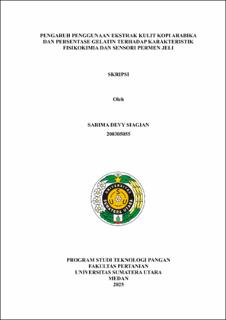Pengaruh Penggunaan Ekstrak Kulit Kopi Arabika dan Persentase Gelatin terhadap Karakteristik Fisikokimia dan Sensori Permen Jeli
Effect of Using Arabica Coffee Skin Extract and Gelatin Percentage on the Physicochemical and Sensory Characteristics of Jelly Candy

Date
2025Author
Siagian, Sarima Devy
Advisor(s)
Romauli, Nauas Domu Marihot
Suhaidi, Ismed
Metadata
Show full item recordAbstract
Coffee skin is a residual product produced after the process of stripping
coffee and then drying it. Coffee skins have a unique taste and have many benefits,
including their ability to ward off free radicals, protect the stomach, and have
benefits for the skin. This study was aimed to determine the effect of using Arabica
coffee skin extract and gelatine percentage on the physicochemical and sensory
characteristics of coffee jelly candy. The research design used was a factorial
Completely Randomized Design (CRD) model with 2 factors, namely the
percentage of coffee skin in water (K): (10%; 20%; 30%) and the percentage of
gelatine (10%; 15%; 20%; 25%). The parameters analyzed included color index
(oHue), total dissolved solids (oBrix), hardness (g), cohesiveness, springiness (mm),
gumminess, chewiness, water content (%), ash content (%), pH, reducing sugar
(%), antioxidant activity (µg/mL), hedonic value of color, aroma, taste, texture, and
general acceptance.
The best treatment for coffee jelly candy is the K3G2 treatment using 30%
coffee skin extract and 15% gelatine percentage, with a color index of 67,9865oHue,
total dissolved solids 65,4401oBrix, hardness 153 g, cohesiveness 0,79, springiness
2,62 mm, gumminess 121,62, chewiness 121,92, water content 19,5466%, ash
content 0,7156%, pH 3,21, reducing sugar 3,0703%, antioxidant activity
154,39 µg/mL, color hedonic 5,78 (like), aroma hedonic 5,65 (like) , taste hedonic
6,15 (like), texture hedonic 5,94 (like), and general acceptability 6,33 (like).
Collections
- Undergraduate Theses [635]
